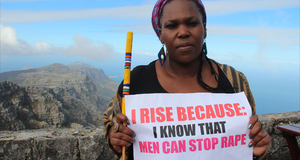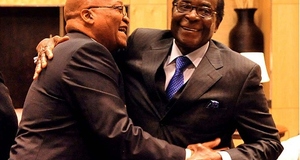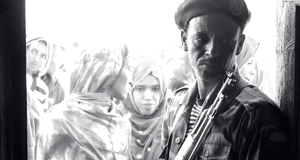Featured Article:Identity in Conflict: Race and Violent Crime in South Africa in the Context of Contemporary Insurgencies
By
2011, Vol. 3 No. 03 | pg. 4/4 | « ConclusionContemporary war theory acknowledges that the categories war and crime are not mutually exclusive. In this article, it was argued that some of the motivating factors of both criminal and war violence – including poverty, potential wealth, and identity politics – often overlap. As in contemporary insurgencies, identity politics play an important role in some forms of violent crime, and indeed the violence of the new South Africa has much in common with the violence of contemporary conflicts – not to mention the comparability of the scale and intensity of violence. Although identity is a human construction, it becomes reified in conflict environments and serves as a justification for committing violence against innocent civilians, particularly if they become regarded as responsible for the wrongs of society, or worse even, if they are regarded as less than human. As violence continues, alienation deepens, scarring the social fabric of South Africa again. Future research can follow Ross, Mirowsky and Pribesh in quantifying the effect that violent crime has had on community relations in South Africa so far. If violent crime is seen as a security issue sharing some characteristics with counterinsurgencies, Cock’s (2005: 803) contention that economic issues are a greater threat to human security in South Africa than military threats and should therefore be prioritized, is underscored by contemporary counterinsurgency theory. Counterinsurgency theory sees conflict as multidimensional – Kilcullen (2006: 4) refers to the security, political, and economic aspects as the “three pillars” of counterinsurgency.No counterinsurgency can be won without a legitimate political approach and economic incentives, and the same applies to crime: police alone will not end violent crime. Kilcullen (2009: 13) argues, “perhaps counter-intuitively for some, activities to kill and capture terrorists seem (and are) offensive at the tactical level but are in fact strategically defensive, because they contain the problem rather than resolving it.” Without addressing the issues of identity politics and poverty, racially based violence will remain endemic to South Africa. This article has focused on the political element, particularly the utilization of identity politics as a means of diverting attention away from government failures and the violent human cost of such a strategy. South Africa cannot hope to achieve a peaceful, non-racial society if the narrative “whites are rich because they exploited blacks” is not debunked in the public consciousness, but at the same time it would be naïve to propose an alternative narrative as the silver bullet for South Africa’s numerous violent problems. As in counterinsurgency, a holistic approach must be followed that addresses all three pillars of the conflict, of which identity is but one small part. ReferencesAltbeker, A. 2005. Puzzling statistics: Is South Africa really the world’s crime capital?, SA Crime Quarterly, 11, March. Altbeker, A. 2007. A Country at War with Itself: South Africa's crisis of crime, Johannesburg: Jonathan Ball. Ballantine, C. 2004. Re-thinking ‘whiteness’? Identity, change and ‘white’ popular music in post-apartheid South Africa, Popular Music, 23(2), 105–131. Barolsky, V. and Pillay, S. 2009. A call for comparative thinking: Crime, citizenship and security in the global South, SA Crime Quarterly, 27, March, 15-21. Betz, D. 2008. The virtual dimension of contemporary insurgency and counterinsurgency, Small Wars & Insurgencies, 19(4), 510-540. Boyle, B. 2009. Mbalula: Innocents will die in crime war, Times, 12 November, http://www.timeslive.co.za/news/article192513.ece. Braid, D. 1996. Personal Narrative and Experiential Meaning, The Journal of American Folklore, 109, 431, Winter, 5-30. Bruce, D. 2010. ‘The ones in the pile were the ones going down’: The reliability of violent crime statistics, SA Crime Quarterly, 31, March, 9-17. Carr, D. 1986. Narrative and the Real World: An Argument for Continuity, History and Theory, 25(2), May, 117-131. Cock, J. 2005. 'Guards and guns': Towards privatized militarism in post-apartheid South Africa, Journal of Southern African Studies, 31(4), 791-803. Collier, P. and Hoeffler, A. 1998. On Economic Causes of Civil War, Oxford Economic Papers, 50, 563-573. CSVR 2007. The violent nature of crime in South Africa. A concept paper for the Justice, Crime Prevention and Security Cluster, Centre for the Study of Violence and Reconciliation. Curtis, V.J. 2006. Note to file - On "non-trinitarian" conflict, Canadian Army Journal, 9(2), 110-115. De Wet, T. 2009. 'White dogs will be killed', Volksblad, 8 January. Duyvesteyn, I. and Angstrom, J. 2005. Rethinking the nature of war, New York: Frank Cass. Ferguson, H. 2004. The Sublime and the Subliminal: Modern Identities and the Aesthetics of Combat, Theory, Culture & Society, 21(3), 1–33. Francis, M. 2009. Farm attacks and moral panics, 4 November, Available: http://www.thoughtleader.co.za/michaelfrancis/2009/11/04/farm-attacks-and-moral-panics/ [2 December 2009]. Gibson, J.L. and Claasen, C. 2009. Racial reconciliation in South Africa: Interracial contact and changes over time, September, http://claassen.wustl.edu/JSI09.pdf. Giliomee, H. 2004. Die Afrikaners. 'n Biografie, Cape Town: Tafelberg. Hamel, E., Brodie, M. and Morin, R. 2005. A survey of South Africa ten years into the new democracy, International Journal of Public Opinion Research, 351-363. Hermann, D. 2009. Transformasie en vervreemding. Paper presented at conference: SA Universities: Political flashpoints or centers of excellence, Bloemfontein. Hoffman, F.G. 2007. Conflict in the 21st century: The rise of hybrid wars, Virginia: Potomac Institute for Policy Studies. Hough, P. 2008. Understanding global security, New York: Routledge. Jefthas, D. and Artz, L. 2007. Youth violence: A gendered perspective, in Burton, P. (ed.) Someone stole my smile. An exploration into the causes of youth violence in South Africa, Cape Town: Centre for Justice and Crime Prevention Monograph series 3. Jütersonke, O., Muggah, R. and Rodgers, D. 2009. Gangs, Urban Violence, and Security Interventions in Central America, Security Dialogue, 40(4-5), August/October, 373–397. Kaldor, M. 2005. Elaborating the 'new war' thesis, in Duyvesteyn, I. and Angstrom, J. (ed.) Rethinking the nature of war, New York: Frank Cass. Kaldor, M. 2006. New & old wars. Organized violence in a global age, Cambridge: Polity. Kilcullen, D.J. 2006. Three Pillars of Counterinsurgency, Remarks delivered at the U.S. Government Counterinsurgency Conference, Washington D.C., 1-8. Kilcullen, D. 2007. Counterinsurgency in Iraq: Theory and Practice, 2007, Virginia: Seminar at the Marine Corps Base at Quantico. Kilcullen, D. 2009. The accidental guerrilla. Fighting small wars in the midst of a big one, London: Hurst & Co. Kilcullen, D. 2010. Counterinsurgency, London: C. Hurst & Co. Kriel, J. 2009. Kill Boer kill Farmer, 4 September, Available: http://www.facebook.com/group.php?gid=124461055694#/topic.php?uid=124461055694&topic=10609 [4 November 2009]. Krug, E.G., Dahlberg, L.L., Mercy, J.A., Zwi, A.B. and Lozano, R. 2002. World report on violence and health, Geneva: World Health Organization. Landman, K. and Schönteich, M. 2002. Urban Fortresses: Gated communities as a reaction to crime, African Security Review, 11(4), 71-85. Langman, L. and Scatamburlo, V. 1996. The Self Strikes Back: Identity Politics in the Postmodern Age, in Geyer, F. (ed.) Alienation, ethnicity, and postmodernism, London: Greenwood. Mair, S. 2003. The New World of Privatized Violence, Internationale Politik und Gesellschaft , 2, 11-28. Marston, D. and Malkasian, C. (ed.) 2008. Counterinsurgency in modern warfare, New York: Osprey. Mbembe, A. 2006. 2010 Soccer World Cup: Where is the moral argument?, 31 October, Available: http://www.africultures.com/php/index.php?nav=article&no=5757 [18 November 2010]. McCafferty, R. 2003. Murder in South Africa: a comparison of past and present, United Christian Action. Melander, E., Öberg, M. and Hall, J. 2009. Are 'New Wars' More Atrocious? Battle Severity, Civilians Killed and Forced Migration Before and After the End of the Cold War, European Journal of International Relations, 15(3), 505–536. Metz, S. 2008. New Challenges and Old Concepts: Understanding 21st Century Insurgency, Australian Army Journal, 5(2), Winter, 27-40. Mirowsky, J. and Ross, C.E. 1983. Paranoia and the Structure of Powerlessness, American Sociological Review, 48(2), April, 228-239. Mngxitama, A. 2010. The face of white supremacy, Mail and Guardien Online, 8 November, http://www.mg.co.za/article/2010-11-08-the-face-of-white-supremacy. Moolman, N. 2000a. The socio-political background of farm attacks in South Africa, Acta Criminologica, 13(1), 49-56. Moolman, N. 2000b. Farm attacks: are there any ulterior motives?, Acta Criminologica, 13(2), 64-74. Münkler, H. 2005. The new wars, Cambridge: Polity. Neal, A.G. and Collas, S.F. 2000. Intimacy and alienation: Forms of estrangement in female/male relationships, New York: Garland Publishing. Neu, C.E. 2005. America's lost war. Vietnam: 1945-1975, Illinois: Harlan Davidson. Newham, G. 2008. Reclaiming our homes? Tackling residential robbery in Gauteng, SA Crime Quarterly, 23, March, 7-12. Petraeus, D. 2006. The U.S. Army and Marine Corps Counterinsurgency Field Manual, Washington: Department of the Army and Department of the Navy. PRAAG 2010. Whites suffer abuse and racism in South Africa, says liberal institute, 8 April, Available: http://praag.co.uk/news/southern-africa/483-whites-suffer-abuse-and-racism-in-south-africa-says-liberal-institute.html [17 November 2010]. Roodt, D. 2009. Stuur ons af op ‘n blanke volksmoord?, 13 September, Available: http://www.plaasmoorde.com/ [3 November 2009]. Ross, C.E. and Mirowsky, J. 1987. Normlessness, powerlessness, and trouble with the law, Criminology, 25(2), 257-278. Ross, C.E., Mirowsky, J. and Pribesh, S. 2001. Powerlessness and the Amplification of Threat: Neighborhood Disadvantage, Disorder, and Mistrust, American Sociological Review, 66(4), August, 568-591. Schönteich, M. 2000. South Africa's position in Africa's crime rankings, African Security Review, 9, 4, http://www.iss.co.za/pubs/asr/9No4/Schonteich.html. Schuermans, N. and Visser, G. 2005. On Poor Whites in Post-Appartheid Cities: The Case of Bloemfontein, Urban Forum, 16(4), October-December, 259-294. Senekal, B.A. 2010. “Die lied van die nuwe jong Suid-Afrika”: Die representasie van vervreemding in hedendaagse Afrikaanse protesmusiek, Tydskrif vir Nederlands en Afrikaans, in press. Shapiro, M.J. 2009. Managing Urban Security: City Walls and Urban Metis, Security Dialogue, 40, 4-5, August/October, 443–461. Sheehan, M. 2007. The changing character of war, in Baylis, J., Smith, S. and Owens, P. (ed.) The globalization of world politics: An introduction to international relations, New York: Oxford University Press. Small, M. and J.D., S. 1982. Resort to Arms: International and Civil War, 1816-1980, Beverly Hills: Sage. Smith, M.R.L. 2005. Stategy in an age of low-intensity warfare: why Clausewitz is still more relevant than his critics, in Duyvesteyn, I. and Angstrom, J. (ed.) Rethinking the nature of war, London: Frank Cass. Strydom, H. and Schutte, S.C. 2005. A theoretical perspective on farm attacks in the South African farming community, Acta Criminologica, 18, 1, 115-125. Stuijt, A. 2009. Two more South African farmers killed: Death toll now at 3,037, Digital Journal, February, p. http://www.digitaljournal.com/article/267463. Taylor, M. 2003. The Vietnam War in history, literature and film, Edinburgh: Edinburgh University Press. United States Government Interagency Counterinsurgency Initiative 2009. US Government Counterinsurgency Guide, Bureau of Political-Military Affairs. Valji, N., Harris, B. and Simpson, G. 2004. Crime, Security and Fear of the Other, SA Reconciliation Barometer, 2, 1, June, http://www.csvr.org.za/wits/articles/artvhgs.htm. Van Creveld, M. 2008. The Changing Face of War. Combat from the Marne to Iraq, New York: Ballantine Ward, C.L. 2007. Young people's violent behavior: Social learning in context, in Burton, P. (ed.) Someone stole my smile. An exploration into the causes of youth violence in South Africa, Cape Town: Centre for Justice and Crime Prevention Monograph series 3. Warwick, R. 2009. Is SA crime a 'race war'?, Cape Argus. www.genocidewatch.org 2002, Available: http://www.genocidewatch.org/BoersSlain01.htm [7 May 2009]. www.iraqbodycount.org 2009, Available: http://www.iraqbodycount.org/ [4 Mei 2009]. www.iraqbodycount.org 2011, January, Available: http://www.iraqbodycount.org/database/ [17 January 3011]. www.saps.gov.za 2010, Available: http://www.saps.gov.za/statistics/reports/crimestats/2010/totals.pdf [18 November 2010]. Endnotesi.) In Small and Singer’s (1982) typology of a civil war, post-apartheid South Africa could be described as fighting a civil war. Collier and Hoeffler (1998: 567) give a summary of Small and Singer’s criteria, “First, one of the primary actors in any conflict identified as a civil war must be the national government in power at the time hostilities begin. Secondly, the concept of war requires that both sides have the ability to inflict death upon each other. As a rule of thumb Singer and Small (1982) define that in a civil war the stronger forces must sustain at least five percent of the number of fatalities suffered by the weaker forces. This rule enables them to distinguish genuine war situations from massacres, pogroms and purges. Thirdly, significant military action must take place. Only civil wars that resulted in at least 1,000 battle related deaths per year are included in the data set. This figure includes civilian as well as military deaths. Fourthly, the war must be internal to the country.” ii.) In Vietnam for instance, the conflict was between Communists and Catholics, but also between Catholics and Buddhists, and between the Vietnamese and Montagnards (see e.g. Neu 2005). iii.) An example of class-motivated violence in South Africa is jackrolling, which involves gang members abducting and raping young women who they consider higher than them on the social ladder. Jefthas and Artz (2007: 46) claim jackrolling “is viewed by many of those living in the townships as a sport of tough gangsters and is regarded as nothing more than a game or popular form of male behaviour indulged in by young boys.” Strydom & Schutte (2005: 118) also note that farm attacks are sometimes motivated by status. iv.) Elsewhere, CSVR (2007: 65) is as careful about racial motivations of violent crime, “the balance of available evidence is that vindictive racial hostility is not a key factor driving violent and other crime. Considering the legacy of racial oppression and discrimination one might expect that such hostility would be a major factor in South Africa. However, while the evidence does not seem to support the idea that such hostility is a key factor in violence, it does play a role in some crime incidents.” Suggested Reading from Inquiries Journal
Inquiries Journal provides undergraduate and graduate students around the world a platform for the wide dissemination of academic work over a range of core disciplines. Representing the work of students from hundreds of institutions around the globe, Inquiries Journal's large database of academic articles is completely free. Learn more | Blog | Submit Latest in Political Science |


















